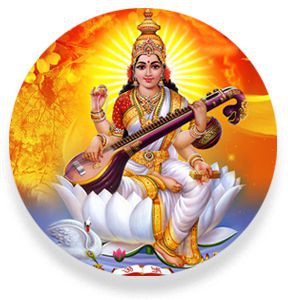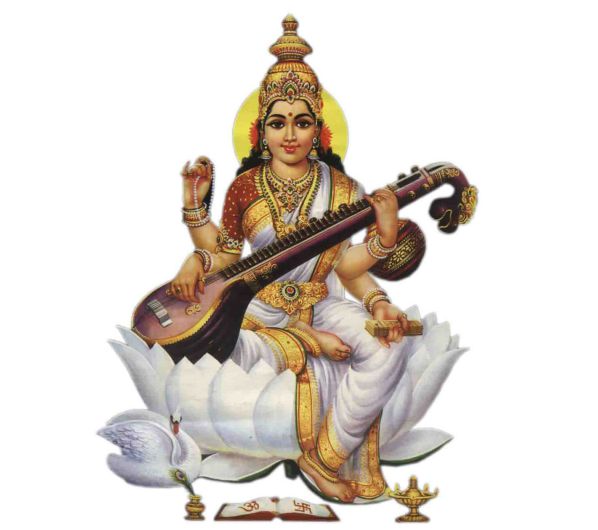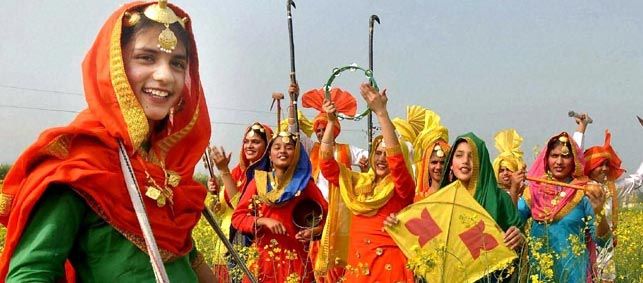No products in the cart.
Goddess Saraswati – Hindu Goddesses and Deities
 Saraswati (Sanskrit: सरस्वती, Sarasvatī) is the Hindu goddess of knowledge, music, arts, wisdom and learning. She is a part of the trinity of Saraswati, Lakshmi and Parvati. All the three forms help the trinity of Brahma, Vishnu and Shiva to create, maintain and regenerate-recycle the Universe respectively.
Saraswati (Sanskrit: सरस्वती, Sarasvatī) is the Hindu goddess of knowledge, music, arts, wisdom and learning. She is a part of the trinity of Saraswati, Lakshmi and Parvati. All the three forms help the trinity of Brahma, Vishnu and Shiva to create, maintain and regenerate-recycle the Universe respectively.
Saraswati is the Sakti, the power and the consort of Brahma the creator. Hence she is the procreatrix, the mother, of the entire creation.
The earliest known mention of Saraswati as a goddess is in Rigveda. She has remained significant as a goddess from the Vedic age through modern times of Hindu traditions. The Goddess is also revered by believers of the Jain religion of west and central India, as well as some Buddhist sects. In the rigveda she represents a river and the deity presiding over it. Hence, she is connected with fertility and purification. Saraswati represents power and intelligence from which organized creation proceeds.
She is considered as the personification of all knowledge-arts, sciences, crafts, and skills. Knowledge is the antithesis of the darkness of ignorance. Hence she is depicted as pure white in color. Since she is the representation of all sciences, arts, crafts and skills she has to be extraordinarily beautiful and graceful. She is worshiped by all persons interested in knowledge, especially students, teachers, scholars, and scientists.
Saraswati, sometimes spelled Sarasvati, is a Sanskrit fusion word of Sara (सार) which means essence, and Sva (स्व) which means one self, the fused word meaning “essence of oneself”, and Saraswati meaning “one who leads to essence of self knowledge”. It is also a Sanskrit composite word of surasa-vati (सुरस-वति) which means “one with plenty of water”.
Other Names of Goddess Saraswati
Saraswati is known by many names in ancient Hindu literature. Her name literally means the one who flows, which can be applied to thoughts, words, or the flow of a river. She is the deity of a river in the Rig-veda. Her other names include Sarada (giver of essence), Brahmani (goddess of sciences), Brahmi (wife of Brahma), Mahavidya (holder of supreme knowledge), Bharati (eloquence), Bharadi (goddess of history), Vani and Vachi (both referring to the flow of music/song, melodious speech, eloquent speaking respectively), Varnesvari (goddess of letters), Kavijihvagravasini (one who dwells on the tongue of poets), Maha-vidya (transcendent knowledge), Arya (noble one), Maha-vani (the transcendent word), Kamadhenu (like the wish-fulfilling cow), Dhaneshvari (the divinity of wealth), and Vagishvari (mistress of speech). It is through speech that knowledge manifests in action. It is through her that language and writing is revealed.
Saraswati, The Wife of Brahma
Lord Brahma is known for creating the universe. Since knowledge is required for creation, Maa Saraswati signifies the creative power of Brahma. An apt creation requires sound knowledge. The creation of Lord Brahma became fruitful with the knowledge provided by Goddess Saraswati.
Saraswati Iconography
In the images, she is generally depicted as a beautiful and graceful goddess clad in spotless white apparel and seated on a white Nelumbo nucifera lotus seat, which symbolizes light, knowledge and truth). She holds in her four hands a VIQa (lute), Ak~amala (rosary) and Pustaka (book). Though these are most common, there are several variations. Some of the other objects shown are: Pasa (noose), Ailkusa (goad), Padma (lotus), Trisula (trident), Sailkha (conch), Cakra (discus) and so on. She is usually depicted with water or a river in the background, suggestive of her association with the river Saraswati, and peacock standing nearby.
Occasionally she is shown with five faces or with eight hands. Even three eyes or blue neck are not uncommon. In this case she is the MahaSaraswati aspect of Durga or ParvatL
Though no separate carrier vehicle is mentioned, Harhsa or swan, the vehicle of Brahma, her spouse, is usually associated with her also. In popular mythological literature and pictures, a peacock is also shown as her carrier vehicle.
A book in her left hand represents all areas of secular sciences. Mere intellectual learning, without a heart tempered by higher feelings, sentiments and emotions, is as dry as saw-dust. So she holds a VIQa (lute) on which she actually plays, to show the need for the cultivation of fine-arts. Then there is the Ak~amala (rosary) held in the right hand. This symbolises all spiritual sciences or Yoga including Tapas (austerities), meditation and Japa (repetition of the divine name). By holding the book in the left hand and the rosary in the right hand she is obviously teaching us that spiritual sciences are more important than secular sciences.
The peacock with its beautiful plumage stands for this world in all its glory. Since the attractions of the world lead the spiritual aspirant astray, the peacock cans actually symbolise Avidya (ignorance or nescience). On the other hand the swan, which is supposed to possess the peculiar power of separating milk from water, stands for Viveka (wisdom, discrimination) and hence for Vidya (knowledge). Though it is true that Vidya or Paravidya (spiritual illumination).
The river imagery of Saraswati represents a migration from a world of ignorance or bondage to a shore that represents enlightenment and freedom. This religious quest represents a state of transition or rebirth in which a spiritual pilgrim sloughs off his old self and is born again, free and enlightened.
Goddess Saraswati – Festivals and Vrats
Saraswati’s is remembered on Vasant Panchami (Saraswati’s birthday) is a Hindu festival celebrated every year on the fifth day of spring (about February). In Hindi language, the word ” basant / vasant” means ”spring” and ”panchami” means the fifth day.
Hindus celebrate this festival with great fervour in temples, homes and educational institutes alike. It is also celebrated as Shikshapatri Jayanti. On this day, yellow is the predominant color as all are garbed in bright yellow clothes. This has to do with the onset of spring and the blooming of yellow mustard flowers in the fields. There is a great deal of festivity with the flying of colorful kites. This day marks the beginning of the spring season.
Saraswati Mantra
Moola Mantra:
“Om Aim Saraswatyai Namah”
OR
“Om Sum Saraswathaye Namah”
Saraswati Gayatri Mantra:
Aum Saraswatye Cha Vidmahe
Brahmaputriye Cha
Dheemahi Tanno Sarasvati Prachodayat”
Saraswati Temples
Shrines dedicated to Saraswati are commonly seen in many Saivite temples all over south India, located to the right of Parvati’s shrine. There are Saraswati temples in Deupatan, Kamalakshi, Thimi, Bhadrakali and Swyambhu, Neel Saraswati at Gairidhara, among others in the Kathmandu Valley. Saraswati Temple in the University of Roorkee. Prthudakeshwara Temples in Pehowa, Haryana. They were built by the Marathas in honour of Saraswati. Saradamba Temple in Sringeri. Sarada Temple in the Neelam Valley in Kashmir. Basar: Situated 50 Kms from Nizamabad at Basara ,on the banks of river Godavari, the Sri Gnana Saraswathi Temple is the only temple in South India dedicated to the Goddess of Learning. The Vilma Vashi temple in Dilwara is also dedicated to Sarasvati.



